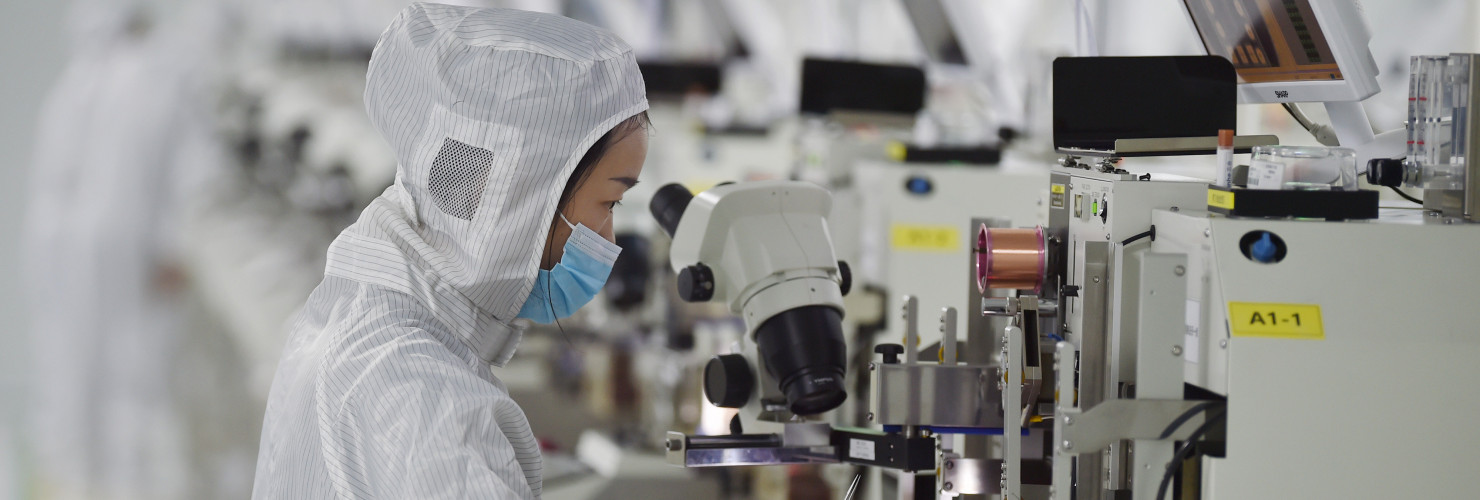

China's competition-based research model + Tax benefits for chips and machinery + Metaverse
MERICS Top 5
1. China’s wish list: MIIT incentivizes research in 52 technologies
At a glance: The MIIT has released a call for companies to apply for 52 “innovation challenges” in metaverse, humanoid robots, brain-computer interfaces and general Artificial Intelligence (AI). Innovation challenges as a concept refers to a competition-based research model whereby policymakers identify important technologies and select promising teams in competition with other teams to develop them with government support for a financial reward. The overall aim is to develop technologies in future industries.
All tasks include certain technical parameters that need to be met, such as the walking speed of a humanoid robot or the processing capacity of AI chips. Companies, financial institutions, research centers and universities are eligible to apply for the tasks by November 10. The government is supportive of entities to form teams with up to five members and expects initial results by 2025.
MERICS comment: The call’s technology focus reflects a clear emphasis on horizontal technologies – those that can be applied across a wide range of industrial sectors – capable of enhancing productivity, safety, and efficiency. Developing the 52 technologies is meant to upgrade traditional industries and ensure that China remains competitive in manufacturing sectors.
The innovation challenges mechanism is meant to concentrate research on strategic technologies, broaden participation in research efforts and introduce competition. The competition aspect – also present in Beijing’s Little Giant initiative – is becoming a staple in Chinese industrial policy to boost innovation. Yet, questions linger about the other two aspects. It is questionable whether the mechanism will genuinely redirect support to previously excluded entities, or merely serve as another channel for subsidies to politically well-connected companies. Furthermore, can the government accurately identify promising emerging technologies in a rapidly evolving landscape? Breakthroughs can happen unexpectedly and the focus on these 52 technologies could draw resources and talent away from promising but not-prioritized research areas.
While foreign companies are not a priori excluded from participation, they are not the target audience of the policy. Beijing's intent is clear: fostering the rise of Chinese companies as technology leaders to bolster the nation's technological self-reliance. Still, if successful, the horizontal nature of many of these technologies could strengthen China's attractiveness as an industrial base for foreign firms, allowing them to increase their productivity and efficiency.
Article: On Organizing Future Industrial Innovation Tasks for the Year 2023 (工业和信息化部办公厅关于组织开展2023年未来产业创新任务揭榜挂帅工作的通知) (Link)
Issuing body: MIIT
Date: September 13, 2023
2. Turn it up a notch: Beijing raises R&D tax credits for chips and machinery
At a glance: Four government agencies led by the Ministry of Finance announced an increase to the deduction ratio of research and development (R&D) expenses for integrated circuit and industrial machinery companies. According to existing regulations, companies can deduct 100 percent of R&D expenses before tax. The new regulation increases the deduction to 120 percent of R&D expenses until December 31, 2027. It also increases amortization of the cost of intangible assets like patents from 200 to 220 percent.
For integrated circuits, the policy refers to previous regulations outlining the companies that are eligible. For industrial machinery, which has not been as much of a focus in recent years, the regulation lays out what kind of companies can receive these benefits with technology thresholds. This includes:
- CNC and metal cutting machine tools with high accuracy
- Casting equipment with high through-put and high clamping force
- High-pressure forging equipment
- Modern welding equipment with high accuracy and compensation
MERICS comment: China’s government has supported integrated circuit companies for years. They have benefited from a multitude of support, including income tax benefits, staggered by how important they are for plugging China’s technology gaps. The more up-to-date the technology, the higher the tax incentives. In past regulations, the integrated circuits industry was often combined with the software industry for tax benefits.
Companies have since made significant progress in software, with Huawei offering an alternative to Germany’s SAP and the US’s Oracle, Meta ERP. There is now a Chinese alternative to Windows, a Linux-based OS called KylinOS, and a Chinese smartphone system, HarmonyOS. However, China’s advances in chip manufacturing are less clear. Industrial machinery has been identified as another large technology gap and vulnerability, which could be a reason China’s government has put industrial machinery and integrated circuits together in the same tax credit regulation.
While the policy could support R&D in these companies, and therefore help plug these technology gaps, it can only play a small role, and the increase from 100 to 120 percent is unlikely to play a decisive role for company decision-making.
Article: Announcement on Increasing the Super Deduction Ratio of R&D Expenses for Integrated Circuit and Industrial Machinery Enterprises (关于提高集成电路和工业母机企业研发费用加计扣除比例的公告) (Link)
Issuing bodies: MOF, SAT, NDRC, MIIT
Date: September 12, 2023
3. Betting big on the Metaverse
At a glance: The Ministry of Industry and Information Technology (MIIT) and four other ministries released a three-year plan for the innovation and development of its new Metaverse industry. By 2025 policymakers intend to:
- Cultivate three to five large metaverse companies with global influence in the ecosystem, and many SMEs with specific applications. Develop three to five industrial clusters around the new industry.
- Strengthen the R&D efforts of relevant core technologies including AI, blockchain, cloud computing, and virtual reality. Specific technologies mentioned are digital twins, tangible user interfaces (e.g., motion tracking) and generative AI.
- Focus on building the “Industrial Metaverse,” which aims to update key industries with metaverse technologies. Examples include digital twins of production lines and AI-powered logistics management.
MERICS comment: The policy shows China charging ahead in an effort to digitally transform its industries, with an eye on boosting the real economy by investing in the new industry. Regional governments including Shanghai, Beijing, Henan, and Zhengzhou have all announced significant plans to build out metaverse ecosystems. The emphasis on using these technologies to solve industrial problems, rather than applying them to social and entertainment uses, is consistent with Beijing’s cautious attitude and strict controls on gaming and cryptocurrencies.
The timing of a big push for the metaverse may seem surprising, when attention has largely turned towards generative AI in the private sector. A closer look reveals the Chinese government has in mind a more comprehensive set of technologies covering big data, machine learning and generative AI as well. By pushing for R&D in the next generation of technologies, Beijing wants to stay ahead of the curve – the objective of founding “globally influential” firms demonstrates a desire to become the standard bearer for future ecosystems in these technologies. Foreign companies may watch the developments closely for inspiration in their home markets, although any direct participation in China’s metaverse may prove tightly regulated and therefore difficult.
Article: Three-Year Action Plan to Innovate and Develop the Metaverse Industry (2023-2025) (工业和信息化部办公厅 教育部办公厅 文化和旅游部办公厅 国务院国资委办公厅 广电总局办公厅关于印发《元宇宙产业创新发展三年行动计划(2023—2025年)》的通知) (Link)
Issuing bodies: MIIT, MOE, MCT, SASAC, NRTA
Date: August 29, 2023
4. Beijing issues industry-focused growth plans as the economy sputters
At a glance: Central government ministries and agencies led by the MIIT released a series of industry specific plans aiming to stabilize growth over the period 2023–2024. The documents seek to boost domestic consumption, upgrade supply and strengthen the industrial chains, as well as stabilize foreign trade and investment. Examples of targets laid out in the plans include:
- Automotive: In 2023, boost new energy vehicle (NEV) sales by 30 percent and increase the value-added output of the car industry overall by about five percent compared to 2022.
- Machinery: Reach an average growth rate of three percent or more in business revenue by 2024; cultivate about ten industrial clusters with output of CNY 100 billion each.
- Petrochemical and chemicals: Achieve an average value-added annual growth rate of about 5 percent in 2023–2024; improve the business environment and encourage foreign firms to increase their investments in the petrochemicals and chemical industries in China.
Other plans covered sectors such as the power equipment, building materials, and non-ferrous-metals industries.
MERICS comment: Beijing is trying to stimulate more growth in the short to medium-term through this flurry of policy activity. It is a clear response to the sluggish performance of industry so far this year. For instance, growth in value-added output for the general machinery sector has been negative since June, while output for special machinery shrank in August. But this package of growth stabilization plans looks unlikely to have a real impact.
That is because the plans offer limited measures designed to boost domestic consumption, such as increased NEV sales through tax incentives and public sector procurement. Rather, the focus is on enhancing the quality of supply and boosting exports, for instance through deepened cooperation with Belt and Road countries and emerging markets.
The promises that China will improve the business environment for foreign enterprises keep coming. Yet much like the 24 directives issued in August to stimulate foreign investment, Beijing will need to provide more tangible incentives to convince wary foreign firms to deepen investments in China at this time of heightened geopolitical uncertainty.
Article: Work Program for Stabilizing Growth in the Automotive Industry (2023-2024) (工业和信息化部等七部门关于印发汽车行业稳增长工作方案(2023—2024年)的通知) (Link)
Issuing bodies: MIIT, MOF, MOT, MOFCOM, GAC, NAFR, NEA
Date: September 1, 2023
Article: Work Program for Stabilizing Growth in the Machinery Industry (2023-2024) (工业和信息化部等七部门关于印发《机械行业稳增长工作方案(2023—2024年)》的通知) (Link)
Issuing bodies: MIIT, MOF, MOA, MOFCOM, GAC, NAFR, NMPA
Date: September 1, 2023
Article: Work Program for Stabilizing Growth in the Petrochemical and Chemical Industries (工业和信息化部 国家发展改革委 财政部 生态环境部 商务部 应急管理部 中华全国供销合作总社关于印发《石化化工行业稳增长工作方案》的通知) (Link)
Issuing bodies: MIIT, NDRC, MOF, MEE, MOFCOM, MEM, ACFSMC
Date: August 26, 2023
5. Fast iterations: Growing the market for domestic, good-enough hardware
At a glance: The MIIT, National Development and Reform Commission (NDRC) and State-owned Assets Supervision and Administration Commission (SASAC) issued a policy that encourages state-controlled or majority-state-owned firms to procure major technical equipment that is new on the market. Highlights include:
- Ensure that tenders and other procurement processes remain fair for established and newly marketed equipment. Tenders should not require information on market share and application performance, which would discriminate against new entrants.
- Exclude bids that involve remote control from outside the country. Personal and important data should remain in China. Applicants need to comply with the Cybersecurity Law, the Data Security Law, the Personal Information Protection Law and other relevant regulations.
- Consider advances in technological innovation, green and low-carbon development, and industry chain security during bid evaluation.
A wide range of equipment falls under this scope, such as energy, construction, and medical devices, as defined by a catalog that MIIT issued in 2019. Officials suggest that the categories for machinery, cars, electronic equipment, and ICT will be expanded in an updated version.
MERICS comment: The policy seeks to speed up product development and marketing cycles, enabling Chinese firms to climb the value chain and challenge foreign competitors. Using their market power to promote the take-up of first pieces (sets) of major equipment is a way for state-owned enterprises (SOEs) to promote self-reliance and break foreign technology strangleholds, as SASAC director Zhang Yuzhuo said.
The policy builds on a subsidized insurance scheme launched in 2019 that lowered the risk for (private) firms to purchase domestically developed equipment. The impact of that policy has been mixed. In many sectors, Chinese businesses still favor imports for their proven reliability and quality.
Framed as addressing unfair competition and monopolistic behavior, the policy’s bias against foreign firms is relatively subtle. It is difficult for foreign firms to keep data in-country because the business models in this sector increasingly rely on predictive maintenance and other services that require intense data flows and analysis. Compliance with Chinese cyber and data regulations is complicated by unclarity over their implementation. Additionally, foreign firms can claim their products to be “first in kind,” but only if they register the core intellectual property (IP) in China.
Article: Guiding Opinions on Supporting the Equal Participation of First Pieces (Sets) of Major Technical Equipment in Corporate Bidding and Tendering (工业和信息化部 国家发展改革委 国务院国资委关于支持首台(套)重大技术装备平等参与企业招标投标活动的指导意见) (Link)
Issuing bodies: MIIT, NDRC, SASAC
Date: September 20, 2023
Noteworthy
Policy news
- August 29: The MIIT released opinions to build an advanced manufacturing technology innovation system by 2027, including a library of key technology strengths to guide companies and local governments (MIIT notice)
- September 5: The MIIT and the China National Intellectual Property Administration released an Action Plan for intellectual property to support industrial innovation and development; policymakers want companies in priority sectors to have nearly four high-value patents per CNY 100 million in income (MIIT notice)
- September 9: Multiple government authorities led by the Ministry of Finance announced that they would prolong preferential tax policies for incubators, science parks, and maker spaces until 2027 (MOF notice)
- September 19: The MIIT and the National Medical Products Administration released the list of medical device companies shortlisted for first batch of biomedical materials innovation tasks; MERICS analyzed the call for applications in February (MIIT notice)
- September 23: The Ministry of Education released a list of 43 national-level vocational training bases (State Council notice)
Corporate news
- September 10: The President of Panasonic Software Development Center Dalian, Zhang Xue, revealed that Panasonic has deepened its R&D presence in Dalian and scaled up staff from about 700 to roughly 1,000 people between 2020 and 2022 (Nikkei Asia article)
- September 11: He Dongfeng, chairman of Commercial Aircraft Corporation of China, stated that orders for China's home-grown C919 aircraft have risen to 1,061, up from about 300 at the end of 2022 (Yicai article, MERICS Comment)
- September 20: The European Union Chamber of Commerce in China (EUCCC) released its Position Paper for 2023/2024, highlighting the deterioration of perceptions of China as a predictable and reliable market among EU businesses (EUCCC Position Paper)
- September 20: German direct investment into China in the first half of the year dropped to EUR 10.31 billion compared to EUR 12 billion in the first half of 2022, according to data analyzed by the IW institute (Reuters article)
- September 22: China’s NEV manufacturer Nio released a smartphone model to better connect phones and cars, making it the only carmaker to have developed its own smartphone (Yicai article)
- September 24: Chinese battery material supplier Huayou Cobalt announced it will build three plants together with South Korean EV battery maker LG Chem for nickel ore processing, lithium battery cathode precursors, and lithium salt processing (Yicai article)




